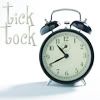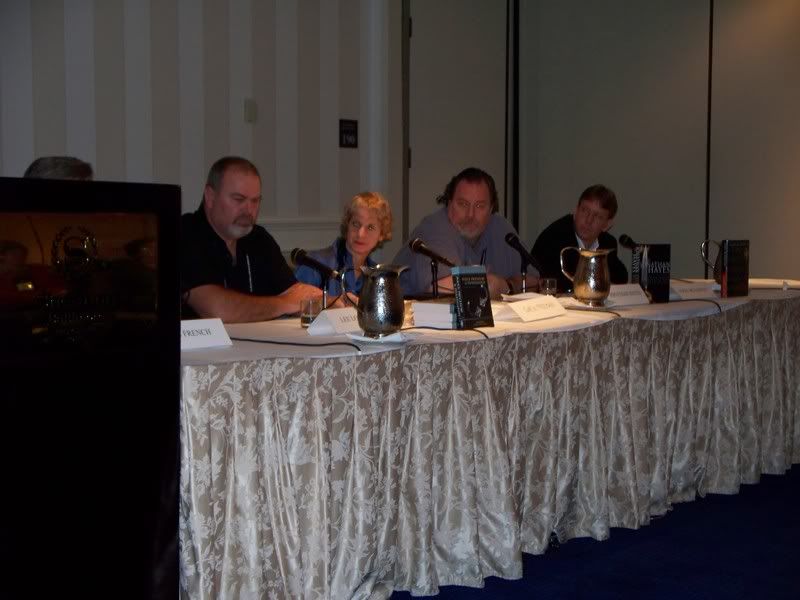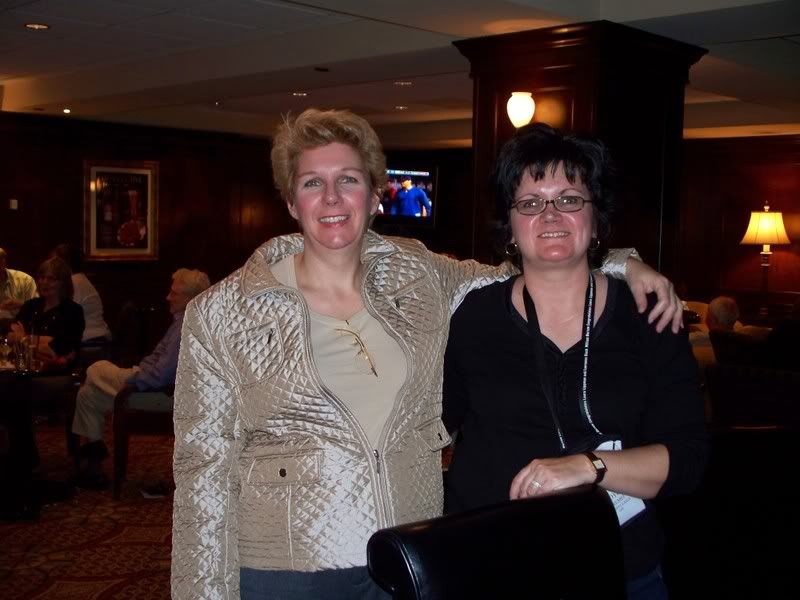By Martha Reed
Halloween is one of my favorite holidays because even if you take it seriously it still comes out like fun. No one is responsible for planning a big meal or get-together. If you don’t have the money to shop for presents you can still enjoy the heck out of it by digging through your closet and coming up with something creative to wear that can be even more rewarding than buying an outfit straight off eBay. You can loosen up and be politically incorrect and carve the face of a presidential candidate onto a pumpkin. It’s a holiday that hasn’t been sanitized; it’s still slightly suspect, slightly pagan, and the woo-woo factor is still there. Ghosts, goblins, witches, Darth Vader, Batman’s Joker – all the creatures of the night get to come out and play.
Now I’m not usually one for woo-woo but a story popped up in the latest issue of
Archaeology Magazine (http://www.archaeology.org/0811/etc/witches.html) that gave me the creeps. In the spirit of Halloween, I thought I should share an excerpt with you.
Macabre evidence of age-old spells surfaces in an archaeologist's front yard
By Kate Ravilious
Archaeologist Jacqui Wood holds a fragment of a cauldron unearthed from a buried spring-fed pool near her home. This and other artifacts she has found point to a long history of ritual and witchcraft. (Photo by Manuel Cohen)

Over the centuries, many in the British Isles have appealed to witches in times of need -- to cure a toothache, concoct a love potion, or curse a neighbor. Witchcraft, the rituals of a number of pagan belief systems, was thought to offer control of the world through rites and incantations. Common as it has been over the past several centuries, the practice is secretive and there are few written records. It tends to be passed down through families and never revealed to outsiders. But archaeologist Jacqui Wood has unearthed evidence of more than 40 witchy rituals beneath her own front yard, bringing to light an unknown branch of witchcraft possibly still practiced today.
Wood's home is in the hamlet of Saveock Water in Cornwall, a county tucked in the far southwest corner of the country. For thousands of years people have raised crops and livestock in its fertile valleys, and its coastline of dramatic cliffs, secluded coves, and pounding surf was once a haunt for smugglers. Cornwall is a place time forgot; steeped in folklore, myth, and legend; and purported to be inhabited by pixies, fairies, and elves. So it should come as no surprise that it has also been home to the dark arts.
When I visit Saveock Water it is raining, which adds to its unearthly atmosphere. Wood, a warm lady with sparkling hazel eyes, greets me in her cozy white-washed barn while rain hammers on the roof. She moved to Saveock Water 15 years ago because it was an ideal location for her work in experimental archaeology, replicating ancient techniques, including those used in farming or metallurgy. Since then she has carried out her experiments, such as growing ancient crop varieties, unaware of what lay under her fields. In the late 1990s, Wood decided to do some metalwork research by re-creating an ancient kind of furnace. "I dug down into the ground to construct a shelter close to the furnace and I discovered a clay floor," she says.
Wood was excited but busy with other projects and left the find undisturbed for a few years. In 2001, she gathered some archaeology students to explore it further. "It was a nightmare to dig because the field is covered in a soft rush grass with a dense web of roots, and the soil is heavy and laden with water," says Wood.
While digging a hole for another project, Wood discovered a late Mesolithic clay platform in her field. She found that small pits had been dug into the platform at a later date, and contained bizarre collections of items including swan skins, pebbles, and bird claws. (Manuel Cohen)
As the group peeled off layers of turf, they discovered the clay floor was an extensive man-made platform -- probably a foundation for a group of ancient dwellings. During a break in the rain, Wood takes me out to have a look. What used to be a half-acre marshy field is now a slippery clay surface, covered with small plastic crates protecting finds. Based on flint fragments embedded in the clay, a Danish specialist dated the site to the late Mesolithic, around 8,500 years ago.

But as Wood and her team excavated the platform over the next few seasons, unusual features began to emerge. They came across strange rectangular holes, about 15 by 10 inches, in the clay. "At first we thought they must be postholes or something," says Wood. But the first of the holes, about 6 inches deep, was lined with white feathers. The pits cut through the clay platform, so Wood knew that they had to date to a later time, but only an expensive radiocarbon test could pin it down. "We guessed it might have been a bird-plucking pit, a common farming practice at the turn of the 19th century," says Wood.
But that couldn't be the case -- Wood found that the feathers were still attached to the skin, which had been laid in the pit with the feathers facing inward. A bird expert from the local zoo confirmed they came from a swan. On top of the swan skin, Wood found a pile of pebbles and a number of claws from different birds. She later learned that the stones came from a coastal region 15 miles away, though no one knows why they were brought from so far. Someone had gone to considerable trouble to gather the contents of this pit. That season, Wood and her colleagues found eight pits, two of which contained odd collections of bird parts, and six of which had been emptied, but with a few telltale feathers and stones left behind.
"Over the last 30 years I've been quick to dismiss ritual as an explanation for unusual archaeological finds," says Wood. "It usually means that the archaeologists can't think of anything better. So now it seems especially ironic that I end up with a site absolutely full of ritual."
By that time Wood was convinced that only witchcraft could explain her unusual finds, but no one had ever heard of anything like this. Radiocarbon tests revealed the swan skins dated to around a.d. 1640, the time of civil war in England and a very dangerous period to be practicing witchcraft. "Any sort of pagan worship was classified as witchcraft at that time, and punishable by death," says Wood. "If caught, they would have been burned at the stake." To make things worse, swans were royal symbols and property of the crown, so killing a swan was doubly risky.
And yet witchcraft remained popular, says Marion Gibson of Exeter University, a specialist on 16th- and 17th-century paganism. "Every village would have had people thought to be skilled in magic in one way or another and people in the area would go to them for their specialist services, just as we might go to a lawyer or plumber today."
Wood leads me to one of the pits and pulls the plastic lid off. I get a sense of the shock she must have felt when she found them. Swan feathers line the pit and muddy, wrinkled egg membranes sit on top. A shiver runs down my spine as I imagine someone coming here in the dead of night, digging a hole, and carefully placing these offerings in it. What made them desperate enough to risk death if caught?
Two spring-fed pools on Wood's land were places of ritual offering. Visitors seeking good fortune deposited everything from scraps of cloth, to straightpins, hair, heather branches, and nail clippings. (Manuel Cohen)
One explanation is that some of the pits contained offerings to St. Bridget (or Bride) of Ireland, the patron saint of babies and infants, who may be associated with the pagan goddess Brigid. "My theory is that maybe if you got married and didn't become pregnant in the first year, you might make an offering to St. Bride in a feather pit," says Wood. Women who then became pregnant might have had to empty their pits and burn the contents, she postulates.
Wood and her colleagues had further spooky discoveries ahead. Not far from the three pits, they uncovered the remains of a spring-fed pool, carefully lined with white quartz, and containing 128 textile scraps, six medieval straight pins, shoe parts, heather branches (associated with luck), fingernail clippings, human hair, and -- it doesn't get more witch-like -- part of a cauldron.
"Two of the pieces of fabric contained wool and silk, indicating they originally belonged to someone of high status," says Wood. Others were coarser and may have come from those of lower status. Looking at the textile fragments stored in little plastic boxes in Wood's barn, it is hard to believe they are 350 years old -- the vivid blues, golden yellows, and vibrant greens were preserved by the moist environment.
Further excavation uncovered a stone-lined drain and a second pool that only fills in winter. Wood realized that the pools were much older than their contents, and that this site may have been special to people for thousands of years. Based on stratigraphic evidence, she believes the quartz-lined pools are 6,000 years old. "The white quartz would have made the pools glow in the moonlight, and we think they may have been very special, a place of ritual for people in those times," she speculates.
If the pools do date back that far, they retained their sacred status throughout the ages, as by the 17th century people were using them as a place of offering, throwing in personal fragments (such as fabric and hair) for good fortune. However, the practice stopped in the late 17th century, when the crown paid locals to fill in the pools (along with other "holy" wells in Cornwall) to prevent pagan rituals.
Wood's 2008 field season brought more unusual discoveries. "We have been uncovering some extraordinary animal pits," says Wood. One was lined with the skin of a black cat and contained 22 eggs, all with chicks close to hatching, in addition to cat claws, teeth, and whiskers. Another held a dog skin, dog teeth, and a baked pig jaw. The week prior to my arrival, Wood's students uncovered a pit that contained a mysterious seven-inch iron disk with a swan skin on one side and animal fur on the other.
The biggest shock of all came from the radiocarbon dates for these pits. The cat pit dated to the 18th century, while the dog pit dated to the 1950s. "And I doubt it just suddenly stopped in the 1950s," says Wood. "It is plausible that it could still be continuing now."
Woo-woo. Happy Halloween, everyone!
























